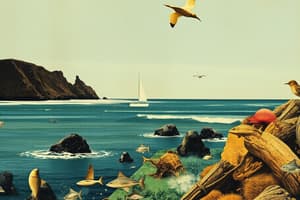Podcast
Questions and Answers
What is an estuary?
What is an estuary?
- A fully enclosed body of fresh water
- A body of saltwater separated from the ocean
- A large body of freshwater with no connection to the ocean
- A semi-enclosed body of fresh water connected to the ocean (correct)
What does a watershed refer to?
What does a watershed refer to?
- An area of land with no water drainage
- A specific type of estuary
- A type of stormwater
- An area of land that drains into a body of water (correct)
What are impervious surfaces?
What are impervious surfaces?
- Surfaces with no impact on stormwater
- Surfaces with natural vegetation and soil
- Surfaces with lots of asphalt, concrete, and roofs (correct)
- Surfaces with high water permeability
What is salinity?
What is salinity?
What is the function of pycnocline in coastal ecosystems?
What is the function of pycnocline in coastal ecosystems?
What is the Redfield Ratio used to sum up in the bay?
What is the Redfield Ratio used to sum up in the bay?
What characterizes diatoms in coastal ecosystems?
What characterizes diatoms in coastal ecosystems?
When do dinoflagellates predominate in coastal ecosystems?
When do dinoflagellates predominate in coastal ecosystems?
What distinguishes intertidal ecosystems from subtidal ecosystems?
What distinguishes intertidal ecosystems from subtidal ecosystems?
What is the primary characteristic of epifauna in coastal ecosystems?
What is the primary characteristic of epifauna in coastal ecosystems?
What is the primary characteristic of infauna in coastal ecosystems?
What is the primary characteristic of infauna in coastal ecosystems?
What does the term 'sessile' refer to in coastal ecosystems?
What does the term 'sessile' refer to in coastal ecosystems?
What does detritus refer to in coastal ecosystems?
What does detritus refer to in coastal ecosystems?
What are phytoplankton in coastal ecosystems?
What are phytoplankton in coastal ecosystems?
What characterizes living shorelines in coastal ecosystems?
What characterizes living shorelines in coastal ecosystems?
Flashcards are hidden until you start studying
Study Notes
Coastal Ecosystems and Environmental Factors
- Zones of maximum turbidity concentrate nutrients and suspended sediment, supporting rapid plankton growth and a rich biological community.
- Pycnocline is a layer that separates high-density saltwater from low-density saltwater.
- The Redfield Ratio sums up the essential nutrients for plant life in the bay, including carbon, nitrogen, and phosphorus.
- Diatoms are single-celled algae with glass-like walls, providing essential food for primary consumers.
- Dinoflagellates, green-blue algae, predominate in the summer, while diatoms are more abundant in the winter.
- Intertidal ecosystems are above water at low tide and underwater at high tide, while subtidal ecosystems are always submerged.
- Epifauna, such as crabs and snails, travel over the flat to feed on plant debris and invertebrates on the mud surface.
- Infauna, including deposit-feeders and meiofauna, live below the mud surface, providing a food source for other organisms.
- Sessile organisms are fixed in one place and do not move.
- Detritus refers to dead or decaying organic matter that accumulates in ecosystems, such as dead plant material in the marsh ecosystem.
- Phytoplankton are autotrophic components of the plankton community, while zooplankton are a type of heterotrophic plankton.
- Living shorelines are a natural approach to erosion control that preserves the coastal edge by planting vegetation and using other natural materials.
Studying That Suits You
Use AI to generate personalized quizzes and flashcards to suit your learning preferences.




